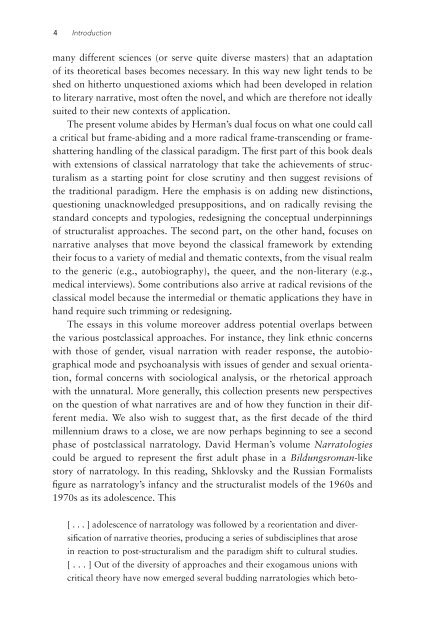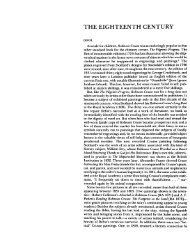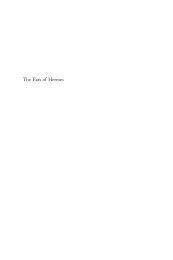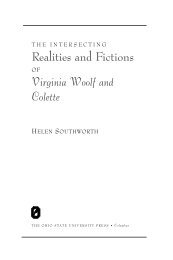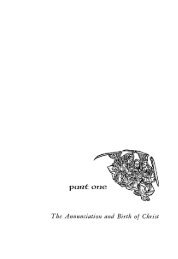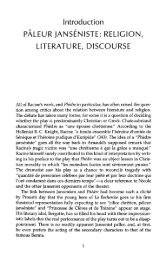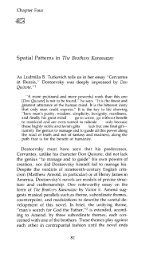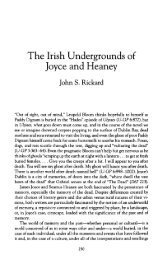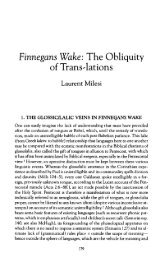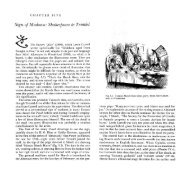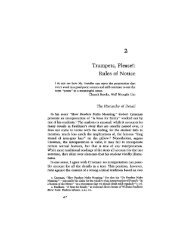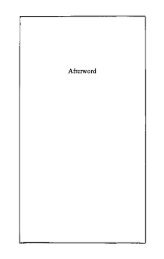Postclassical Narratology: Approaches and Analyses
Postclassical Narratology: Approaches and Analyses
Postclassical Narratology: Approaches and Analyses
You also want an ePaper? Increase the reach of your titles
YUMPU automatically turns print PDFs into web optimized ePapers that Google loves.
4 Introduction<br />
many different sciences (or serve quite diverse masters) that an adaptation<br />
of its theoretical bases becomes necessary. In this way new light tends to be<br />
shed on hitherto unquestioned axioms which had been developed in relation<br />
to literary narrative, most often the novel, <strong>and</strong> which are therefore not ideally<br />
suited to their new contexts of application.<br />
The present volume abides by Herman’s dual focus on what one could call<br />
a critical but frame-abiding <strong>and</strong> a more radical frame-transcending or frameshattering<br />
h<strong>and</strong>ling of the classical paradigm. The first part of this book deals<br />
with extensions of classical narratology that take the achievements of structuralism<br />
as a starting point for close scrutiny <strong>and</strong> then suggest revisions of<br />
the traditional paradigm. Here the emphasis is on adding new distinctions,<br />
questioning unacknowledged presuppositions, <strong>and</strong> on radically revising the<br />
st<strong>and</strong>ard concepts <strong>and</strong> typologies, redesigning the conceptual underpinnings<br />
of structuralist approaches. The second part, on the other h<strong>and</strong>, focuses on<br />
narrative analyses that move beyond the classical framework by extending<br />
their focus to a variety of medial <strong>and</strong> thematic contexts, from the visual realm<br />
to the generic (e.g., autobiography), the queer, <strong>and</strong> the non-literary (e.g.,<br />
medical interviews). Some contributions also arrive at radical revisions of the<br />
classical model because the intermedial or thematic applications they have in<br />
h<strong>and</strong> require such trimming or redesigning.<br />
The essays in this volume moreover address potential overlaps between<br />
the various postclassical approaches. For instance, they link ethnic concerns<br />
with those of gender, visual narration with reader response, the autobiographical<br />
mode <strong>and</strong> psychoanalysis with issues of gender <strong>and</strong> sexual orientation,<br />
formal concerns with sociological analysis, or the rhetorical approach<br />
with the unnatural. More generally, this collection presents new perspectives<br />
on the question of what narratives are <strong>and</strong> of how they function in their different<br />
media. We also wish to suggest that, as the first decade of the third<br />
millennium draws to a close, we are now perhaps beginning to see a second<br />
phase of postclassical narratology. David Herman’s volume Narratologies<br />
could be argued to represent the first adult phase in a Bildungsroman-like<br />
story of narratology. In this reading, Shklovsky <strong>and</strong> the Russian Formalists<br />
figure as narratology’s infancy <strong>and</strong> the structuralist models of the 1960s <strong>and</strong><br />
1970s as its adolescence. This<br />
[ . . . ] adolescence of narratology was followed by a reorientation <strong>and</strong> diversification<br />
of narrative theories, producing a series of subdisciplines that arose<br />
in reaction to post-structuralism <strong>and</strong> the paradigm shift to cultural studies.<br />
[ . . . ] Out of the diversity of approaches <strong>and</strong> their exogamous unions with<br />
critical theory have now emerged several budding narratologies which beto-


